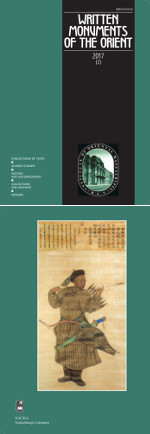 | Written
Monuments
of the Orient 2(6), 2017
Issued twice a year
The entire issue as a *.PDF file
Li Jingrong. The Scribal Hands of the Er nian lü ling Manuscript Unearthed from
Zhangjiashan Han Tomb No. 247 — 3
Contrary to received texts, early Chinese manuscripts written on bamboo strips
have typical physical features, of which handwriting is the significant character. This
paper studies handwriting of the Er nian lü ling manuscript unearthed in the Zhangjiashan
Han tomb No. 247. According to analysis on the monophony of the repeating
characters in the manuscript, it concludes that the manuscript was most likely written by
three scribes. One scribe who mastered professional writing skills and was responsible
for writing more than half of the bamboo strips is the main one among the three. As the
Er nian lü ling manuscript was required for the tomb owner’s funeral, it was written by
three scribes together within a short time resulting in a number of transcribe errors in the
text.
Key words: Handwriting, scribe, legal manuscript, early China, Zhangjiashan
Ching Chao-jung 慶昭蓉. SI 3662 and SI 3663 — two wedge-shaped Kharoṣṭhī documents
from Niya in the Petrovsky Collection — 17
Two unedited wedge-shaped wooden documents SI 3662 and SI 3663
(= SI P 138/a and SI P 138/б, respectively) are deciphered in this paper. A preliminary
analysis of their content and physical features shows that SI 3663 is very probably the
wedge under-tablet to be bound with the wedge covering-tablet N. i. 17 found by Aurel
Stein at the N. I. site (Niya, China). SI 3662, a king’s instruction issued to Soṃjaka the
Cozbo, is in all probability from the Niya sites, too.
Key words: Petrovsky Collection, Niya documents, Gāndhārī, Kharoṣṭhī
Olga Chunakova. A Sogdian Manichaean Parable — 35
The article is devoted to the first publication of the Sogdian fragment SI 5704
from the Serindia Collection at the IOM, RAS. The fragment contains an excerpt from
the popular fable of the turtle and the two birds, widely known in the folklore and literature
of different nations.
Key words: Sogdian, Sogdian Manichaean fable, migratory story, Panchatantra
Kōichi Kitsudō and Peter Zieme. The Jin’gangjing zuan 金剛經纂 in Old Uighur with Parallels in Tangut and Chinese — 43
The Jin’gangjing zuan consists of passages abridged from the Diamond Sutra,
a miraculous story concerning a girl, and the Ten Feast Days and the Twelve Calendric
Days. It expounds the merits of chanting this scripture itself. So far, Chinese and Tangut
versions are edited. This paper provides the edition of the texts in Old Uighur attested in
manuscripts of St. Petersburg and Berlin. The comparative study of the texts reveals that
the Old Uighur version is parallel to the Tangut version.
Key words: Jin’gangjing zuan, Diamond Sutra, Old Uighur, Tangut
Tatiana Pang and Nicholay Pchelin. Portraits of Qing meritorious officers in the collection of the State Hermitage: scroll restoration and revised reading of the texts — 88
The finished restoration of the portraits representing prominent Qing officers
kept in the collection of the State Hermitage resulted in a possibility to not only prove
their artistic value, but also to read the eulogies written by Emperor Qianlong in Manchu
and Chinese. As a follow-up of our previous paper we are presently able to become certain
that the State Hermitage has five portraits (of Yeotun, Fusil, Cebdenjab, Bolbunca
and Guwandase), originally from the Ziguang-ge Pavilion (Hall of Purple Glaze), which
made it to Germany in the early 20th c., and then, after 1945, to Russia. The analysis of
the texts has revealed the peculiarities of Manchu and Chinese poetry at the same time
proving that both versions of the eulogies were written in accordance with corresponding
poetic rules thus becoming variations of the same topic.
Key words: portraits of Qianlong meritorious officers, Qianlong’s poems, the State Hermitage,
the Manchu language, the Chinese language
Dmitrii Nosov. A Manuscript of the Mongolian Folk Tale “About old Borontai” from
the IOM, RAS Collection — 111
The manuscript “About Old Borontai” kept in IOM, RAS, is one of the earliest
written fixations of the cumulative tale common among Mongolian people and well
known to scholars working in the field. The present paper contains the first ever publication
of the manuscript in transcription and translation of the text written in old Mongolian
script based on the Uighur alphabet.
Key words: Mongolian manuscripts, lore, folklore, tales, cumulative tales
Reviews
Zare Yusupova. The Kurdish Dialect Gorani. A Grammatical Description. Saarbrücken: Lambert Academic Publishing, 2017, by Youli A. Ioannesyan — 119
Mitteliranische Handschriften. Teil 2: Berliner Turfanfragmente buddhistischen Inhalts in soghdischer Schrift, beschrieben von Christiane Reck. Stuttgart: Franz Steiner Verlag, 2016 (VOHD; XVIII, 2), 473 S., by Olga M. Chunakova — 122
|

